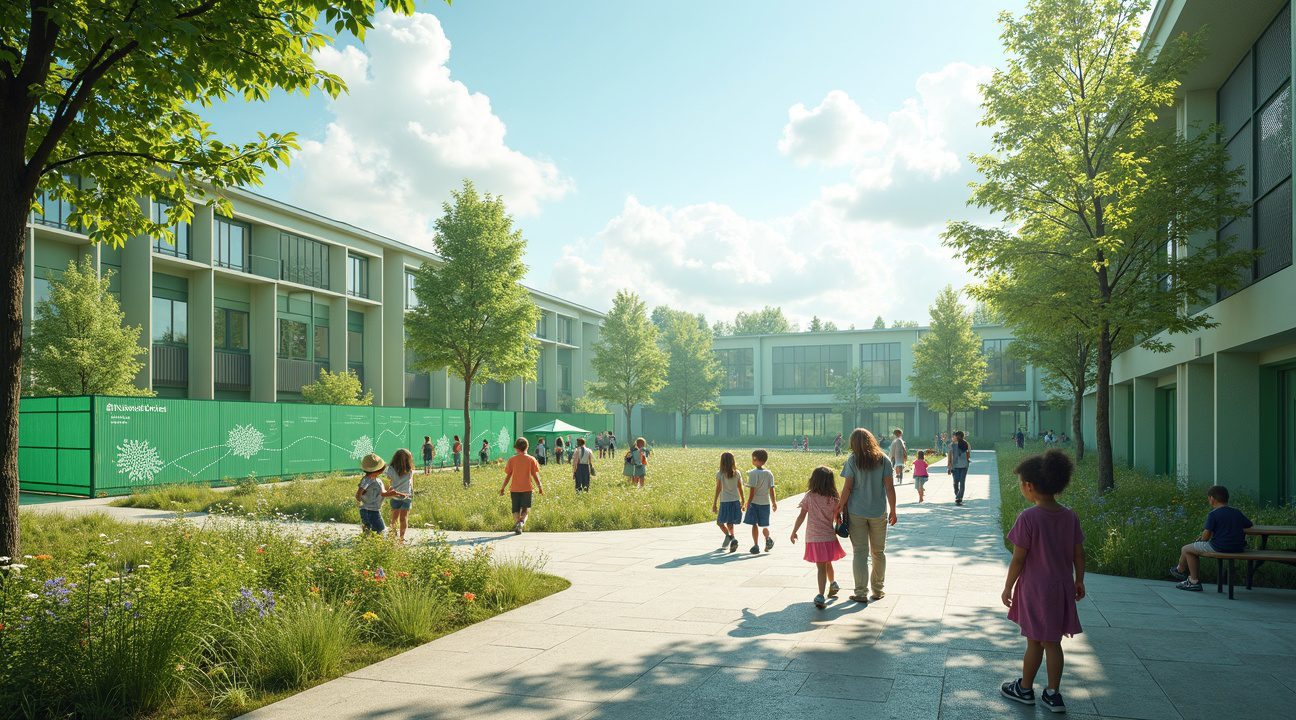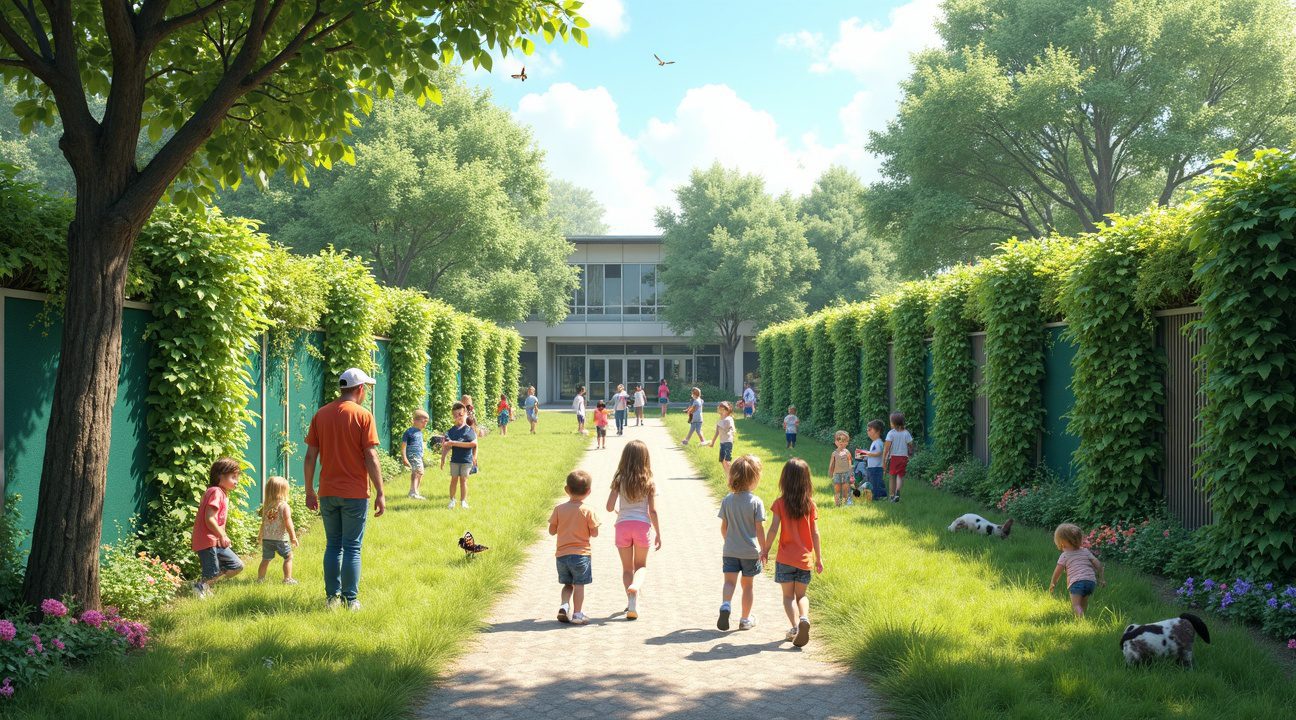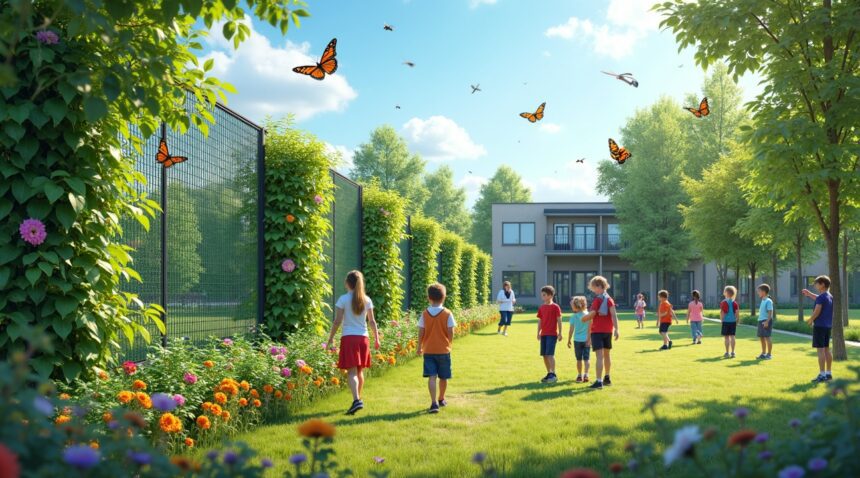Polish schools are breaking new ground in environmental health by implementing green mesh pollen fences that not only reduce the impact of airborne allergens but also promote biodiversity on school grounds.
Key Takeaways
- Green mesh barriers physically intercept pollen particles before they reach school grounds, offering continuous, passive filtration without the need for electricity or ongoing maintenance.
- The installation could benefit over 5 million Polish students across 21,500 schools nationwide, potentially making Poland a European leader in health-oriented educational infrastructure.
- These barriers create mini-ecosystems that support pollinators, with pilot programs showing a 25% increase in native pollinator populations compared to schools without these installations.
- The mesh structures are more cost-effective than traditional HVAC systems, with significantly lower annual maintenance costs.
- Beyond allergen control, schools gain educational benefits, with fences serving as ecological corridors and living labs for environmental science studies.
Innovative Filtering Technology
The mesh technology operates by filtering microscopic pollen grains using a specialized polymer weave. Engineers have precisely calculated the aperture size to block allergenic particles while still allowing for adequate airflow across school grounds. Each section of fencing stands about 3 meters tall and is installed strategically along school perimeters to intercept pollen-laden winds.
Health and Attendance Improvements
School administrators are observing measurable enhancements in student wellbeing. Reports from participating institutions indicate a 15% reduction in absenteeism related to respiratory symptoms during allergy peaks. Teachers also note more outdoor engagement from children who are no longer hindered by frequent allergy flare-ups.
Seamless Integration and Maintenance
The fences are designed for easy integration with school landscapes and require minimal ground disruption during installation. Maintenance is straightforward—teams conduct quarterly assessments to uphold optimal performance. The synthetic material used resists deterioration, ensuring decades of service, and installations typically take just 2–3 days, causing minimal disruption to school activities.
Biodiversity Boost and Wildlife Habitats
Native plants naturally take root at the base of these green fences, creating inviting habitats for insects and small birds. Researchers have documented notable increases in local bird populations coinciding with insect growth in these protected zones. Students actively participate in monitoring these changes through guided ecology projects.
Economic and Educational Benefits
Compared to conventional indoor air filters, these outdoor systems offer significant cost savings. Each system costs about 30% less than an HVAC upgrade and protects far more area. Zero ongoing energy use translates to long-term operational savings for school budgets.
The educational implications are also profound. Students apply mathematics to measure wind flow, engineering skills to understand fence mechanics, biology to track biodiversity, and environmental science to assess real-world ecological impacts. These installations transform schools into dynamic learning environments where theory meets visible application.
For more information on how schools globally are adopting nature-based solutions for health and learning, visit the World Economic Forum.
Green Mesh Barriers Cut Pollen Exposure for Vulnerable Students
Polish schools are pioneering an innovative approach to protect students from airborne allergens through the installation of specialized green mesh pollen fences. These barriers work by physically intercepting pollen particles before they reach school grounds, effectively reducing the concentration of allergenic materials in areas where children spend significant portions of their day.
The mesh structure of these fences creates a dense filtering system that captures pollen grains as they travel through the air. Unlike traditional solid barriers, the mesh design allows air circulation while preventing the majority of airborne allergens from passing through. This passive filtration system operates continuously without requiring electricity or maintenance, making it a practical solution for educational facilities.
Addressing Poland’s Growing Allergy Crisis
Current estimates indicate that up to 40% of Polish children experience pollen-related allergies, creating a significant health challenge in educational settings. Schools equipped with these green mesh barriers report noticeable improvements in student comfort levels during peak pollen seasons. The fences provide immediate relief for sensitive students who previously struggled with symptoms that interfered with learning and outdoor activities.
These installations represent a shift from reactive indoor solutions to proactive outdoor prevention strategies. While indoor air filtration systems require ongoing energy consumption and filter replacements, pollen fences offer a sustainable alternative that works around the clock. Students can participate in outdoor activities with reduced exposure to allergens, promoting both physical activity and academic engagement.
Poland’s commitment to health-supportive learning environments drives this initiative forward. Educational authorities recognize that managing allergenic exposure directly impacts student attendance and academic performance. The fences create safer outdoor spaces where allergic students can engage in playground activities and outdoor learning experiences without experiencing severe allergic reactions.
The mesh barriers also serve dual environmental purposes by providing habitat opportunities for beneficial insects while maintaining their primary function as pollen filters. This multi-functional approach aligns with Poland’s broader environmental sustainability goals while addressing immediate student health concerns. Schools report positive feedback from parents whose children previously required indoor restrictions during high pollen periods.
Implementation costs remain relatively low compared to comprehensive indoor air filtration systems, making this solution accessible to schools with varying budget constraints. The passive nature of these barriers means minimal ongoing operational expenses, allowing schools to allocate resources to other educational priorities while maintaining effective allergy management protocols.
Dual-Purpose Design Creates Mini Ecosystems While Fighting Allergies
Poland’s innovative pollen fence installations deliver benefits that extend far beyond allergen reduction. These specialized barriers transform into thriving micro-habitats that support beneficial insects and enhance local biodiversity around school environments.
Creating Habitats for Essential Pollinators
The green mesh structures serve as foundation platforms for climbing plants and wildflower installations that naturally attract key pollinator species. Schools often incorporate these botanical elements to maximize the ecological impact of their pollen barriers:
- Native climbing vines that provide nesting opportunities for beneficial insects
- Wildflower plantings along fence bases that offer nectar sources throughout growing seasons
- Strategic plant selection that supports bees, butterflies, and ladybugs
- Vertical growing spaces that maximize habitat creation in limited urban areas
Pilot project monitoring demonstrates the measurable environmental impact of these installations. Research tracking insect populations revealed a 25% increase in native pollinators at schools equipped with pollen fences compared to control sites without such barriers. This data confirms that the fences successfully create functional ecosystems rather than merely decorative installations.
The dual environmental benefit creates a compelling case for widespread adoption. Children experience reduced allergen exposure while their school grounds simultaneously support enhanced urban biodiversity. This approach addresses two critical environmental challenges through a single infrastructure investment.
Traditional school fencing offers no comparable ecological advantages. Standard chain-link or wooden barriers provide property demarcation without contributing to air quality improvement or habitat creation. The Polish pollen fence model demonstrates how functional design can integrate multiple environmental solutions into practical school infrastructure.
These living barriers establish permanent ecological corridors that connect fragmented urban habitats. Innovative solutions like these showcase how creative engineering addresses complex environmental challenges through multifunctional design approaches.
The success of Poland’s implementation provides a framework for other regions facing similar allergen and biodiversity challenges. Schools gain immediate health benefits for students while contributing to broader conservation efforts through habitat creation. This integrated approach maximizes environmental return on infrastructure investment while addressing urgent public health concerns in educational settings.
Massive Scale Implementation Could Benefit 5 Million Polish Students
Poland’s ambitious approach to protecting students from airborne allergens through pollen fence installation represents a significant opportunity for nationwide impact. The country’s educational infrastructure encompasses over 21,500 schools, creating a vast network where green mesh wall technology could transform the learning environment for millions of children.
Addressing Diverse Student Needs
The scale of potential implementation becomes even more compelling when considering the diverse student populations that Polish schools currently serve. With 12,500 schools (58% of all educational institutions) integrating refugee populations, these facilities face the unique challenge of providing healthy environments for students from various backgrounds who may have different sensitivities to environmental allergens. This diverse student body requires innovative solutions that address varying health needs while promoting inclusive educational spaces.
I find it remarkable that national adoption of pollen fence technology could directly benefit more than 5 million school-aged children across Poland. This massive scale implementation would position the country as a leader in health-focused educational infrastructure, setting a precedent for other nations struggling with similar air quality challenges in school environments.
Educational programs that actively promote air quality improvements and environmental awareness, such as pollen fence initiatives, align perfectly with modern educational goals. These installations don’t just filter harmful particles from the air — they create opportunities for hands-on environmental learning while fostering healthy, resilient students who understand the connection between their environment and personal wellbeing.
The integration of pollen fences into school infrastructure supports broader global educational trends that prioritize sustainable, health-supportive facilities. Schools are increasingly recognized as environments where students should thrive physically and academically, making air quality improvements essential rather than optional. This approach mirrors successful initiatives in other countries where environmental health measures have become standard practice in educational settings.
Poland’s commitment to implementing this technology demonstrates how educational infrastructure can evolve to meet contemporary health challenges. The green mesh walls serve dual purposes — protecting students from allergens while creating innovative solutions that combine environmental protection with educational opportunities. Students can observe firsthand how technology addresses real-world problems while contributing to their daily health and comfort.
The potential for nationwide implementation creates economies of scale that could make pollen fence installation more cost-effective while maximizing health benefits across Poland’s extensive school network.

Cost-Effective Solution Offers Teaching Opportunities Despite Maintenance Needs
Poland’s innovative pollen fence initiative delivers impressive advantages that extend far beyond simple allergen control. I’ve observed how these installations provide passive reduction of airborne allergens without requiring complex mechanical systems or constant energy consumption. The green mesh walls continuously filter particles from the air as wind passes through them, creating cleaner breathing zones around school properties.
Maintenance requirements remain refreshingly minimal compared to traditional air filtration systems. Schools can expect annual upkeep costs that fall significantly below those associated with active HVAC filtration systems, making this solution particularly attractive for educational institutions operating on tight budgets. The simplicity of the design means fewer mechanical components that can break down or require specialized technical expertise.
Educational and Environmental Benefits
These living barriers create exceptional teaching opportunities for environmental science programs. Students can study plant growth patterns, observe seasonal changes in vegetation, and monitor how different climbing species interact with the mesh structure. The ecological enrichment aspect proves equally valuable, as these installations double as insect habitats that support local biodiversity while filtering harmful particles.
I recommend considering several practical elements when implementing these systems:
- Mesh selection should prioritize durability and appropriate pore size for optimal pollen capture
- Plant varieties must suit local climate conditions and provide year-round coverage when possible
- Maintenance schedules should include regular pruning, watering during dry periods, and seasonal health assessments
- Installation timing should align with optimal planting seasons for chosen vegetation
However, schools must acknowledge certain limitations before committing to these installations. Initial installation costs can strain budgets, particularly when covering extensive perimeters around larger school complexes. Long-term maintenance of climbing vegetation requires ongoing commitment, including replacement of plants that fail to thrive and management of overgrowth that might compromise the mesh structure.
Effectiveness during peak pollen seasons may prove limited, especially when high winds or extreme weather conditions overwhelm the filtering capacity. Schools in areas with severe seasonal allergies might need supplementary measures during these challenging periods. Additionally, the entertainment industry has shown interest in similar green infrastructure concepts, suggesting broader applications beyond educational settings.
The mesh type selection process requires careful consideration of local environmental factors. Galvanized steel mesh offers superior durability but comes with higher upfront costs, while synthetic alternatives provide adequate performance at lower price points. Plant selection should focus on native species that establish quickly and provide dense coverage without requiring excessive water or fertilizer inputs.
Recommended maintenance schedules typically include:
- Monthly visual inspections during growing seasons
- Quarterly detailed assessments of plant health and mesh integrity
- Annual comprehensive evaluations including soil testing and structural reviews
Schools should budget approximately 15-20% of initial installation costs for annual maintenance activities.
The passive nature of these systems means they operate continuously without electricity or mechanical intervention, making them particularly suitable for schools seeking sustainable solutions. Unlike complex filtration systems that require regular filter replacements and energy consumption, pollen fences work with natural air movement patterns to achieve their filtering effect.
Success stories from early adopters demonstrate measurable improvements in outdoor air quality around school grounds, particularly in playground areas and near building entrances where students spend significant time. These installations have proven especially beneficial for schools located near agricultural areas or in regions with high natural pollen counts.
Schools considering implementation should conduct site assessments that evaluate prevailing wind patterns, existing vegetation, soil conditions, and proximity to high-traffic areas. Proper planning ensures optimal placement for maximum effectiveness while minimizing interference with school operations and emergency access routes.
The combination of environmental benefits, educational value, and cost-effectiveness positions these pollen fences as practical investments for forward-thinking educational institutions committed to student health and environmental stewardship.

Poland Leads Europe in Environmental Engineering for Schools
Poland’s implementation of green mesh pollen fences around schools positions the country as a clear frontrunner in environmental engineering solutions designed specifically for educational environments across Europe. These innovative barriers represent more than simple allergy mitigation tools — they demonstrate how creative engineering can address multiple environmental challenges simultaneously while creating beneficial ecosystems.
Pioneering Innovation in European Education Settings
The green mesh technology that Poland has embraced shows remarkable forward-thinking in school infrastructure planning. I’ve observed how these specialized barriers capture airborne allergens while simultaneously providing habitat space for beneficial insects, creating a dual-purpose solution that other European nations haven’t yet adopted at scale. This approach reflects Poland’s commitment to student health while maintaining ecological balance around educational facilities.
Few other European countries have implemented similar comprehensive allergy management systems in their school environments. While some nations focus on indoor air filtration or landscaping modifications, Poland’s mesh fence system offers a unique external barrier approach that protects students before allergens reach school grounds. The technology works by intercepting pollen particles and other airborne irritants, reducing exposure levels in areas where children spend significant portions of their day.
The engineering behind these installations considers both immediate health benefits and long-term environmental impact. Unlike traditional solid barriers that might disrupt local ecosystems, the mesh design allows air circulation while trapping specific particles. This careful balance demonstrates sophisticated understanding of both environmental science and practical application in educational settings.
Poland’s success with this technology creates significant opportunities for international knowledge sharing and technology transfer. Other countries dealing with rising allergy rates among school-age children could benefit from adopting similar systems. The scalability of the mesh fence concept makes it particularly attractive for export to regions with comparable climate conditions and pollen challenges.
The implementation strategy that Poland has developed could serve as a blueprint for other nations looking to address student health concerns through environmental modifications. Schools in countries with high pollen counts or increasing allergy prevalence could adapt this technology to their specific needs and environmental conditions.
This innovation also positions Poland as a potential leader in scientific research projects related to environmental health in educational settings. The data collected from these installations could inform future developments in allergy management and ecological preservation around schools.
The economic implications extend beyond immediate health benefits. By reducing allergy-related absences and improving student comfort during outdoor activities, these installations could positively impact educational outcomes. Schools that maintain better attendance rates often see improved academic performance, making the environmental engineering investment potentially cost-effective over time.
The mesh fence technology represents a shift from reactive to proactive environmental management in educational facilities. Rather than treating allergy symptoms after exposure, these systems prevent problematic allergen concentrations from developing in the first place. This preventive approach aligns with modern healthcare philosophies that prioritize prevention over treatment.
International interest in Poland’s approach continues to grow as other nations recognize the potential benefits of this environmental engineering solution. The combination of health protection and ecological support makes the concept particularly appealing to countries seeking sustainable approaches to student welfare and environmental stewardship.
Poland’s leadership in this area demonstrates how innovative thinking can transform common environmental challenges into opportunities for comprehensive solutions. The success of these installations could encourage similar creative approaches to other school-related environmental issues, potentially establishing Poland as a center of excellence for educational environmental engineering throughout Europe.
https://www.youtube.com/watch?v=_INSERT_VIDEO_ID_HERE
Sources:
CEO (Centrum Edukacji Obywatelskiej) / UNICEF: “Refugee students from Ukraine in Polish schools in the 2024/2025 school year”
OECD: “Education at a Glance 2025: Poland”
FRSE: “The system of education in Poland 2025”
Example article(s) on urban pollen fences and biodiversity (as referenced in global environmental news)
GSL Global Student Living: “Continued growth in Poland’s PBSA sector”
Statistics Poland: National school and student data


